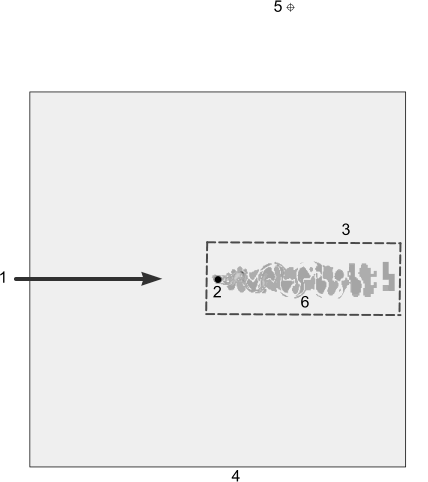Ffowcs Williams-Hawkings (FW-H) Models
The Ffowcs Williams-Hawkings (FW-H) acoustics integral formulation is the preferred strategy for far-field noise prediction such as overhead aircraft noise. The FW-H models allow you to calculate the far-field sound signal that is radiated from near-field flow data from a CFD solution. The goal is to predict small amplitude acoustic pressure fluctuations at the locations of point receivers.

| Index | Description |
|---|---|
| 1 | Flow direction |
| 2 | Impermeable surface that is located on the sources of sound body surface (e.g. cylinder surface) |
| 3 | Permeable surface enclosing the sound sources |
| 4 | Computational domain boundary / Limit of Direct Noise Simulation near-field solution |
| 5 | Receivers in the far field |
| 6 | Quadrupoles noise visualization |
The FW-H acoustic model for stationary motion can simulate wind tunnel aeroacoustic measurements with stationary sources such as aircraft landing gear or an airfoil trailing edge. The FW-H acoustic model is used only to predict the propagation of sound in free space. It does not include effects such as sound reflections, refraction, or material property change.
The Ffowcs Williams-Hawkings formulations are based on Farassat’s Formulation 1A ([46], [55]) and Dunn Farassat Padula 1A ([65]), both for the non-convective form of FW-H. Therefore, numerical accuracy is not an issue of great concern compared to the full Computational Aeroacoustics approach, which explicitly resolves propagation of sound waves all the way to the far field. With the FW-H approach, a second order discretization scheme, both spatial and temporal, together with judicious choices for mesh resolution and time-step size, can give accurate far-field noise prediction.
For input, the FW-H model needs time-accurate data on the near field flow, corresponding to a fine mesh on the near field. The fine meshes used for accurate prediction of the boundary layer or other requirements for turbulence models (such as y+ for LES) are sufficient. The computational domain for this model does not need to include the location of the receivers. However, to use non-reflecting boundary conditions requires a larger domain so a buffer layer can be added to reduce and dissipate the acoustic waves.
The depth of the computational domain must be greater than, or equal to, the acoustic correlation length. This depth is sometimes different from the depth that is required for a good LES simulation. Currently, the FW-H model uses the same solution domain for acoustic sources estimation. When three-dimensional CFD solutions with the FW-H model are periodic in the spanwise direction (for example an infinite cylinder), replicate the solution domain in the spanwise direction. For two-dimensional simulations, a correlation length can be used to overcome this issue.
The FW-H models are available to simulations with porous media. These models describe the propagation of sound in free space and are suited to simulations where porous regions do not affect sound propagation from FW-H surfaces to the receivers. It is a misuse of the FW-H models to use a simulation with porous regions between FW-H surface and receiver points. For simulations with both fluid and porous regions, the FW-H Surface filters allow you to select impermeable and permeable FW-H surfaces from fluid regions, but not from porous regions.
The following Ffowcs Williams-Hawkings models are available in Simcenter STAR-CCM+:
- Ffowcs Williams-Hawkings Steady model
- A model for far-field noise prediction of steady 3-D rotation cases using moving reference frames, with impermeable FW-H surfaces.
- Ffowcs Williams-Hawkings Unsteady model
- Models for far-field noise prediction of transient cases:
- On-The-Fly FW-H model
- An unsteady time model for far-field noise prediction, for both stationary and rotating cases. This model provides the noise prediction in parallel with the aerodynamic computation.
- Post FW-H model
- A unsteady time model for collecting transient flow field data
in .simh files, so that the data can be
used for a far-field noise prediction after the aerodynamic
computation completes, for the following cases:
- Stationary cases with both permeable and impermeable FW-H surfaces.
- Rotating cases with rotating impermeable Post FW-H surfaces, for complete 360-degree domains and for 180-degree periodic domains.